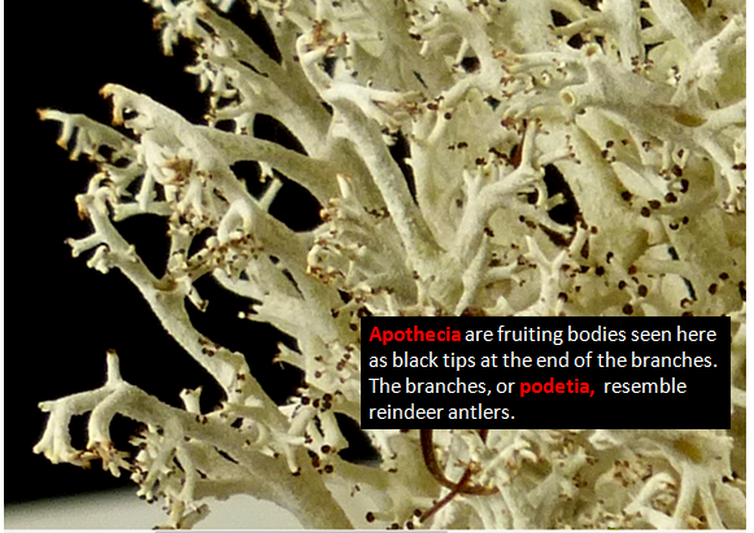Reindeer lichens look like miniature trees and bushes, and are sold for landscaping model train sets. Branches of these lichens are hollow and are made up of fungal hyphae (filaments that comprise the fungal body) within which algal cells are embedded. Darkened tips on the podetia indicate reproductive structures and are composed of fungal spores.
Search the site...
- Home
- About iDigBio and the AR Collection Card Project
- ARPEO Project
- PROJECT REPORT 2022
- Macrofungi: The Daisy Earthstar
- The Consortia of North American Lichens and Bryophytes: Greygreen Reindeer Lichen
- Invertnet Collection Network: The Thorn Bug
- Paleoniches: Brachiopods
- Ammonite
- iDigBio: Channel Catfish
- Great Lakes Invasive Network: Zebra mussel
- Tri-Trophic Thematic Collection Network: Stink Bug Parasitoid
- Macroalgal: Elk Kelp
- Insect Fossils: Tsetse Fly
- SCAN: Earth-boring Scarab Beetle
- InvertEBase: Carolina Mantis
- EPICC: Fossil Crab
- Animal Communication: Ruby-throated Hummingbird
- Poweshiek Skipperling
- RINGTAIL
- Tarantula Hawk
- Sonoran Mantid
- California Leaf-nosed Bat
- Pipevine Swallowtail
- Desert Hairy Scorpion
- Gila Monster
- Ocotillo
- California Poppy
- Anna's hummingbird
- Monarch
- Bumblebee
- White-nosed coati
- Asian Long-horned beetle
- Learning Resources
- Special Thanks
- Give Us Your Feedback!
- Contact Us
- Specimen Cards
- PRIVACY POLICY
- TEST page
- Human Evolution lab
- Skull 8
- Home
- About iDigBio and the AR Collection Card Project
- ARPEO Project
- PROJECT REPORT 2022
- Macrofungi: The Daisy Earthstar
- The Consortia of North American Lichens and Bryophytes: Greygreen Reindeer Lichen
- Invertnet Collection Network: The Thorn Bug
- Paleoniches: Brachiopods
- Ammonite
- iDigBio: Channel Catfish
- Great Lakes Invasive Network: Zebra mussel
- Tri-Trophic Thematic Collection Network: Stink Bug Parasitoid
- Macroalgal: Elk Kelp
- Insect Fossils: Tsetse Fly
- SCAN: Earth-boring Scarab Beetle
- InvertEBase: Carolina Mantis
- EPICC: Fossil Crab
- Animal Communication: Ruby-throated Hummingbird
- Poweshiek Skipperling
- RINGTAIL
- Tarantula Hawk
- Sonoran Mantid
- California Leaf-nosed Bat
- Pipevine Swallowtail
- Desert Hairy Scorpion
- Gila Monster
- Ocotillo
- California Poppy
- Anna's hummingbird
- Monarch
- Bumblebee
- White-nosed coati
- Asian Long-horned beetle
- Learning Resources
- Special Thanks
- Give Us Your Feedback!
- Contact Us
- Specimen Cards
- PRIVACY POLICY
- TEST page
- Human Evolution lab
- Skull 8


